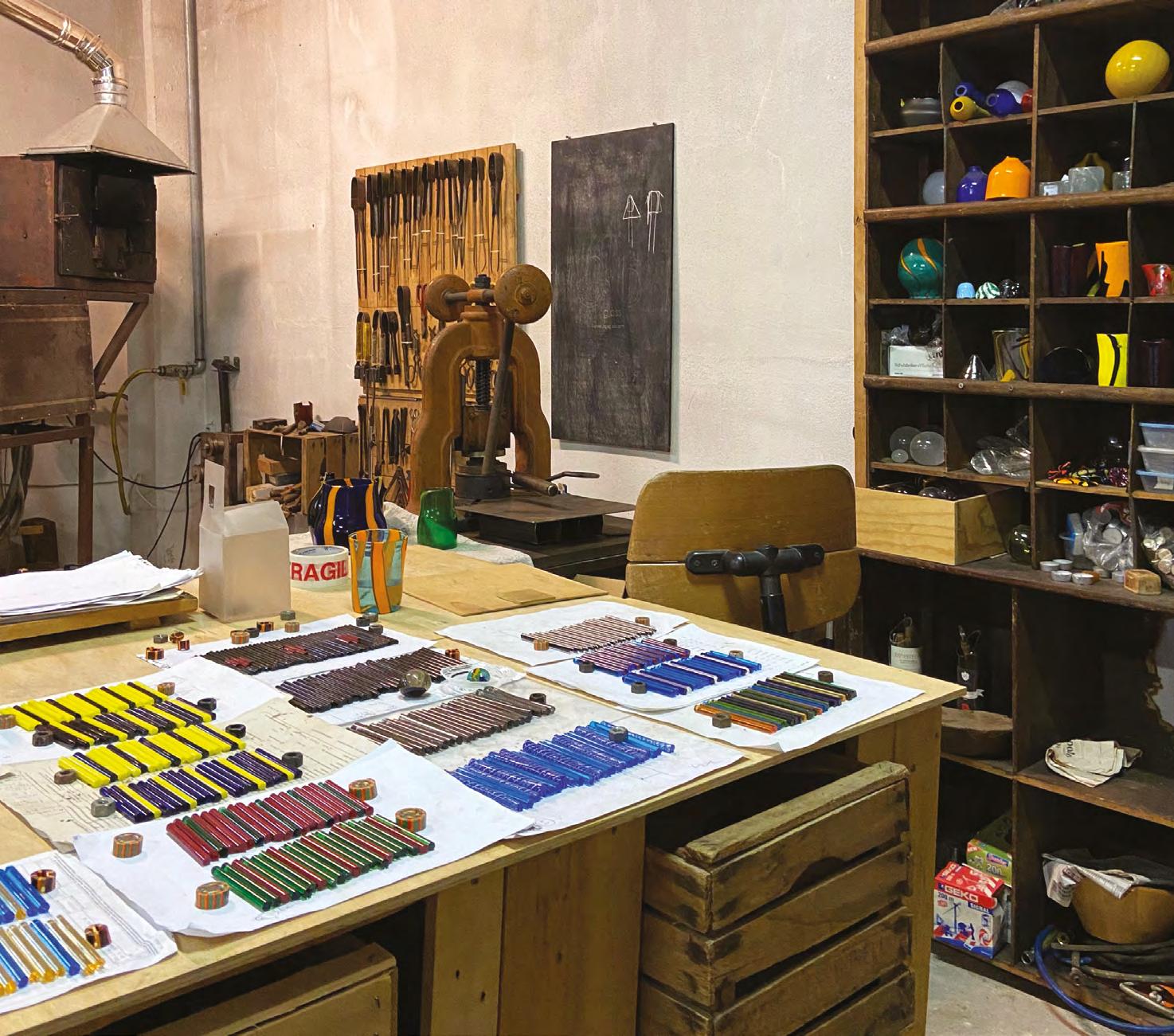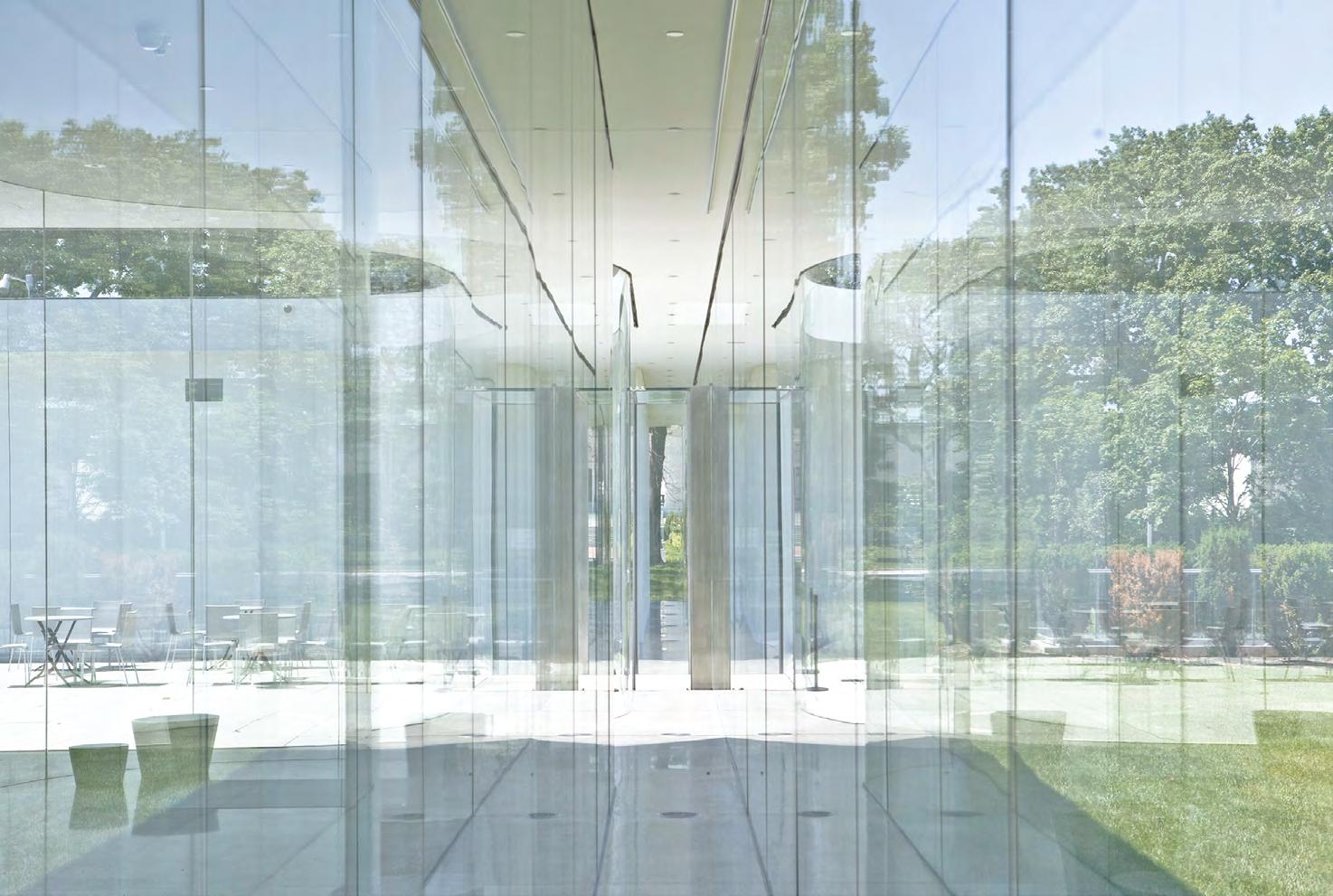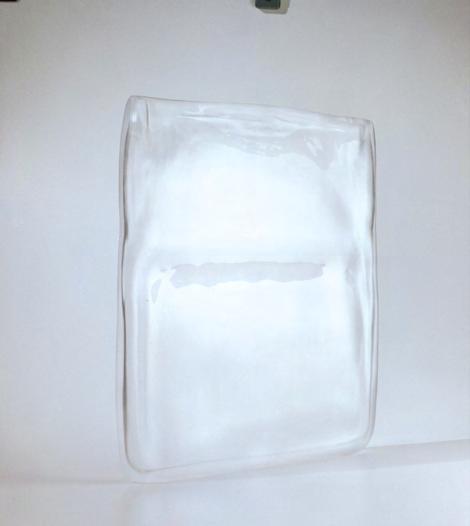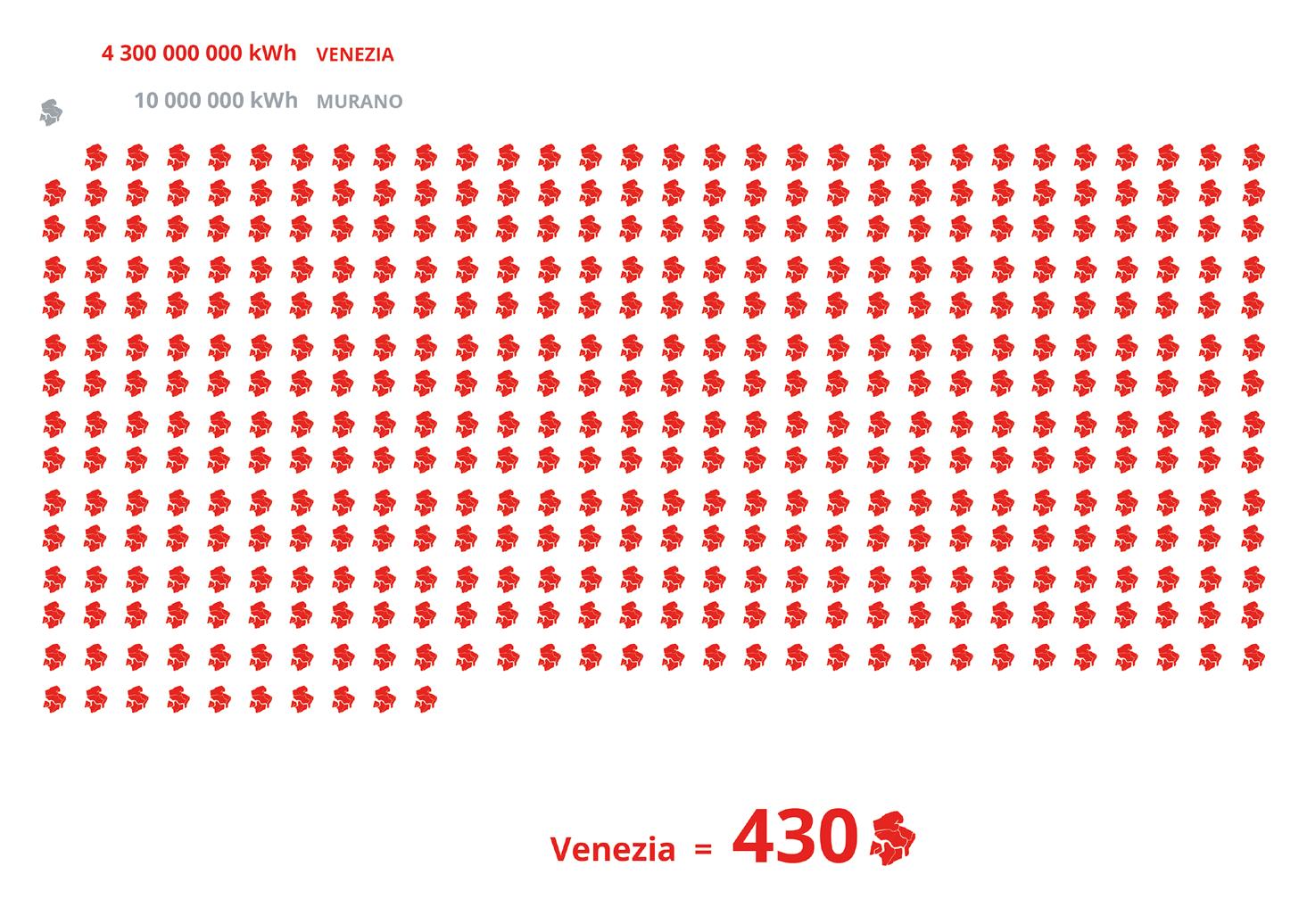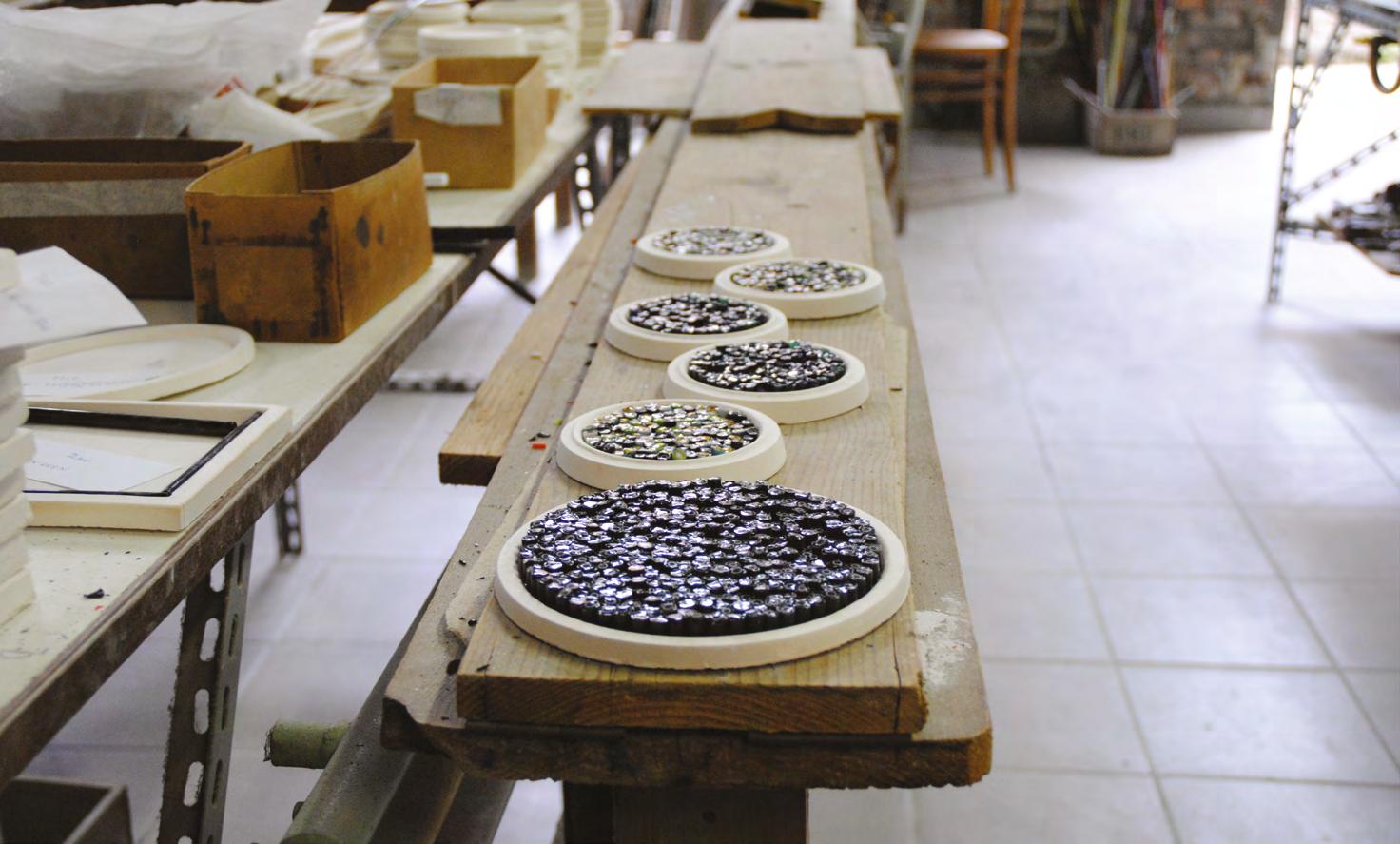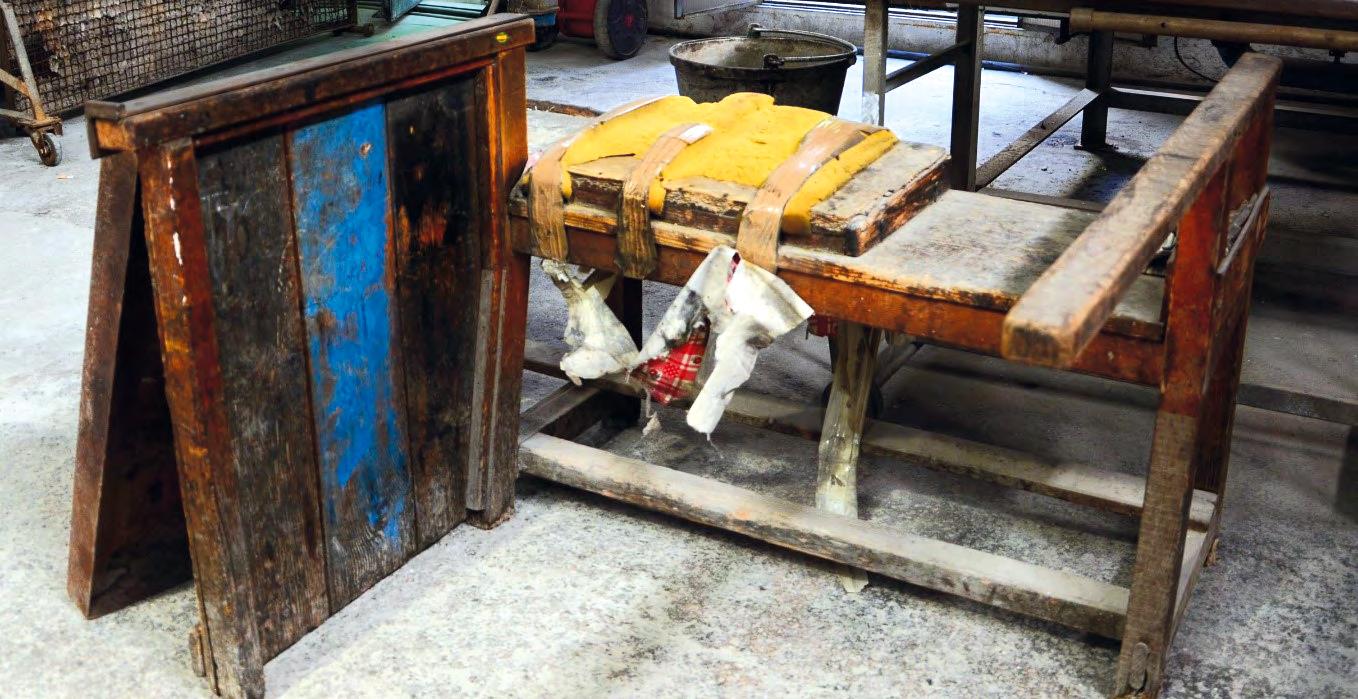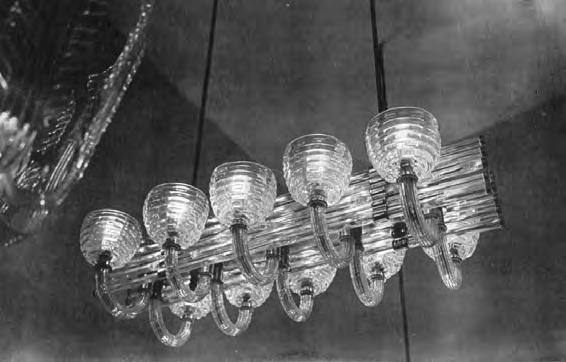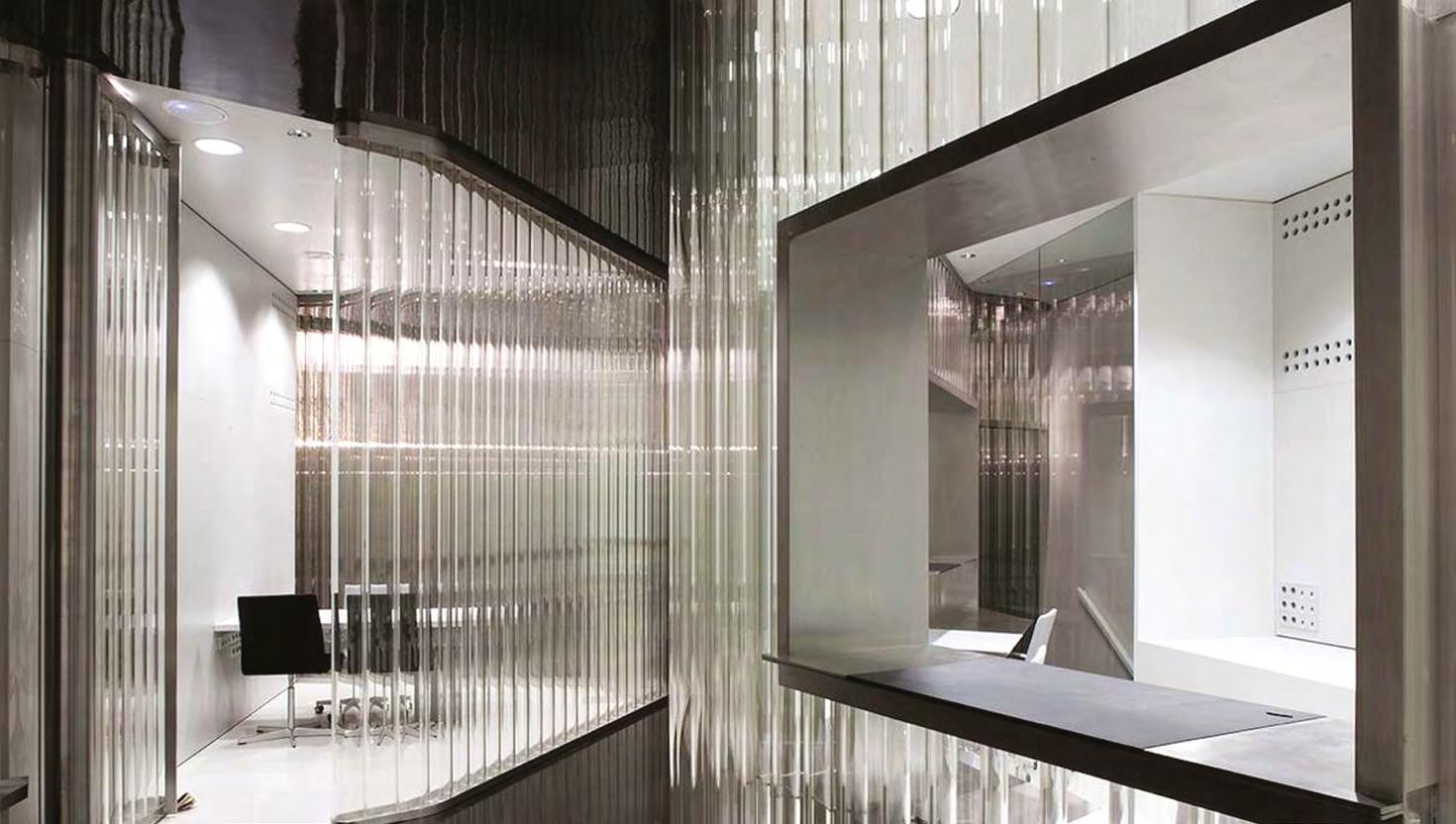
17 minute read
Technology hybridization for multi-performance variable glazing
CRISTIANA CELLUCCIA, BENEDETTA MARRADIB
KEYWORDS: HYBRIDIZATION, DYNAMIC GLAZING, MULTI-PERFORMANCE
The current tendency of contemporary architecture to consider the glass surface as an “interface” between two environments in which a constant exchange takes place “between two substances placed in contact” takes place finds in the glazed elements in the building envelope a vehicle for process and product innovation, both characterized by a focus on forms of contamination/interaction of techniques and materials. These innovations have led both to an improvement of fixed performance products – insulating and laminated glass, absorbing and reflective, selective, low-emissivity – and to an increase of variable performance glazing – transparent aerogels, electrochromic, thermochromic, illuminating, solar electric-generating, etc. The result is the tendency of glass sheets to become a variable multi-performance system that aims to create highly usable and accessible products, with the involvement of sense organs and contamination of creative forms; and to the creation of adaptive facades, which is understood as adaptive to environmental conditions as well as to the user inside. The paper traces the main product and process innovation trajectories of glass panes.
A Department of Architecture and Arts, Università Iuav di Venezia, Venice, Italy. B School of Engineering, University of Pisa, Pisa, Italy.
Introduction
The modern production process has deeply modified the traditional ways of manufacturing by transforming the relationship between the mankind and the means of production, and consequently between the mankind itself and the products, making it possible to foresee and realize almost unlimited quantities of objects at the same time (Nardi, 1979; Losasso, 1991). This capacity for technical reproducibility can be read, in the field of glazing manufacturing process, in a multiple variability of “glass as a product”, due to the transformative capacities that modern technology is able to apply to materials and to interactive features, through the continuous upgrade of its tools.
The current tendency of contemporary architecture to consider the glass surface as an “interface” between two environments in which a constant exchange takes place “between two substances placed in contact”: in this perspective, the application of glazed elements in the building envelope plays a significant role, as an expression of the transition between interior and exterior, private and public spheres, but also increasingly as a vehicle for process and product innovation, both characterized by a focus on forms of contamination/interaction (Campioli, 1993; La Creta and Truppi, 1994).
The first innovation involves the contamination of the glazing manufacturing process with other industrial fields, such as applied chemistry, physics and electrical engineering, which paved the way for adaptive systems capable of responding to multiple and different demands. Such “intelligent components” vary their appearance as a result of interaction with users and/or the surrounding environment (User-centered and EnvironmentCentered Approach), spreading new perspectives from both functional and communicative points of view.
The second innovation concerns the mixing of materials (glass, plastic, metal, and even concrete or wood) and the overcoming of the typical distinction between the portion of the window through which you can look through and the portion that prevents the sunlight and the view. This separation is increasingly being replaced by integrated solutions, or enhanced with additional functions that improve interior acoustics, harvest electrical or thermal energy, or serve as information media for multimedia facades (LED digital strip, electrically generated glass) to lightweight translucent structural solutions (Glass fiber dipped in resin and Glass tubing used as partitions) (Koster, 2004) (Figure 01).
Therefore, this evolution/interaction of techniques and materials has led both to an improvement of fixed performance products – insulating and laminated glass, absorbing and reflective, selective, low-emissivity – and to an increase of variable performance glazing – transparent aerogels, electrochromic, thermochromic, illuminating, solar electric-generating, etc. This results in a tendency for the glass panes to become a variable multi-
Fig. 01 Glass tubing produced by Schott for the Caja de Arquitectos, of NO.MAD in Bilbao. M. de Guzmán
performance system, characterized by a strong interactive component that aims at creating highly usable and accessible products, with the involvement of sense organs and the contamination of creative forms. Glass surfaces embody, today, new values that add to those already experienced by architects, artists, builders and end-users over the past decades, becoming a sort of great “Duchampian glass” through which to look beyond but on which, also, to dwell in order to appreciate what appears on its surface (Maspoli et al., 2012; Dall’Olio, 1997).
Main perspectives in technical innovation
The introduction of new manufacturing techniques with high technological content (i.e. float glass), the improvements for the installation of glazing panels (optimized silicones, thermal break systems, open joint, profile extrusion etc.) and, finally, the search for transparency and daylight enhancement as architectural issues have affected the development of building components, spreading the variety of products and leading to high levels of expressiveness (Sinopoli and Tatano, 2002).
The common ground of this novel approach consists of a focus on the interface between technology and architectural language, environment and industrial innovation, building construction process and architectural design, in the awareness that a specific design solution involves several implications regarding materials and components, both from the morphological and technological-performance aspects. This hiatus between semantic and technical function has characterized the most important innovations on the
production/application of glazed panels and the development of the related technical features: from transparent/translucent to interactive/selective; from small and thick to thin, large and durable.
Due to its high degree of transparency, durability and versatility in various contexts, glass is still the most widely used material when “viewing through” is required. Innovations in this field, which concern the possibility of increasing the standard transparency value of 92 percent up to 98 percent by drastically reducing reflectance (anti-reflective glass), find application in the enhancement of cultural heritage to avoid interference with the perception of an object (i.e. work of art) or a sensitive environment (i.e. historic center of a city).
In the field of safety, recent technological research trends are oriented towards the development of glazed elements capable of assuring the safety of people both as the ability of the sheet to withstand impact and the nonproduction of sharp splinters in the event of sheet breakage.
In addition, at present, hybridization of architectural surfaces (i.e. Switchable Glass) is one of the latest achievements, with the introduction of components as follows: • Smart technologies (Interactive System, Energy Plus System, Smart
System) in use for media communication and light enhancement as urban screens. LED and low-consumption light sources belong to this category, up to the realization of perceptually and kinematically dynamic surfaces. Some example are the translucent methacrylate envelope designed by Peter Cook and Colin Fournier for the Graz
Museum in Austria, on which, thanks to a computerized control, it is possible to remotely adjust both the intensity of the circular fluorescent lights and the vision of movies/videos through projectors placed in the gap between the two façade systems; the facade of the headquarters of the Dutch telecommunications company KPN Telecom by Renzo Piano, in Rotterdam; or Jean Nouvel’s Galleries Lefayette in Berlin. • Smart materials equipped with high-performance and low-power consumption (integration in glass panes of dichroic, photovoltaic, chromogenic films) up to shape memory materials (Shape Memory Alloy) or variable behavior materials, capable of varying their transmission of solar radiation according to environmental conditions automatically and/or by manual control. These innovations result in selective glass, capable of selecting light radiation; holographic, capable of passing visible waves and reflecting thermal ones invisible to the human eye; electrodynamic, capable of varying transmission with an electrical pulse; and thermodynamic, capable of varying coloration and thus absorption as temperature increases. Both the intensity of the opacification and the switching temperature can be customized during the manufacture of the glass, adhering to a wide range of products suitable for different needs and functions.
From the above considerations, it appears that from standardized products and manufacturing processes there has been a progressive trend in expanding standardization to a variable number of types of the same object. This is clear, for instance, in the evolution of glass lamination processes, which, starting from simple deposits between laminated glazing, have allowed the application of fabrics (Allianz Headquarters Zurich), wire mesh, reeds or wood veneers, and LEDs with transparent electrical wiring not visible to the human eye, capable of transforming the glass panel into a lighting fixture or multimedia screen (Lévy, 1994; Galimberti, 1999) (Figure 02).
In addition, glazed panels have evolved towards increasingly lightweight/ thin and mechanically resistant systems. High-strength, chemically toughened glass sheet, which can be produced as thin as 0.5 mm, are used nowadays for smartphones, tablets or photovoltaic modules, but there are no effective obstacles for future architectural applications. Unlike thermally toughened glass, chemically toughened panes are not heated, but are soaked in a salt bath, in which, an ion exchange process “hardens” the most superficial layer. This process not only makes the sheet more resistant to scratching and breakage, but also results in easier shaping in curves with small radii, less weight per unit area (useful for reducing the considerable weight of 4mm sheets used in triple-glazing systems), and simplified installation procedures (with the possibility of reducing the size of the window system components).
In addition to improvements in thickness, the increase of maximum size of the glazed sheets is also evolving. Following the Crystal Palace in London, the first large exhibition building, with approximately three hundred thousand
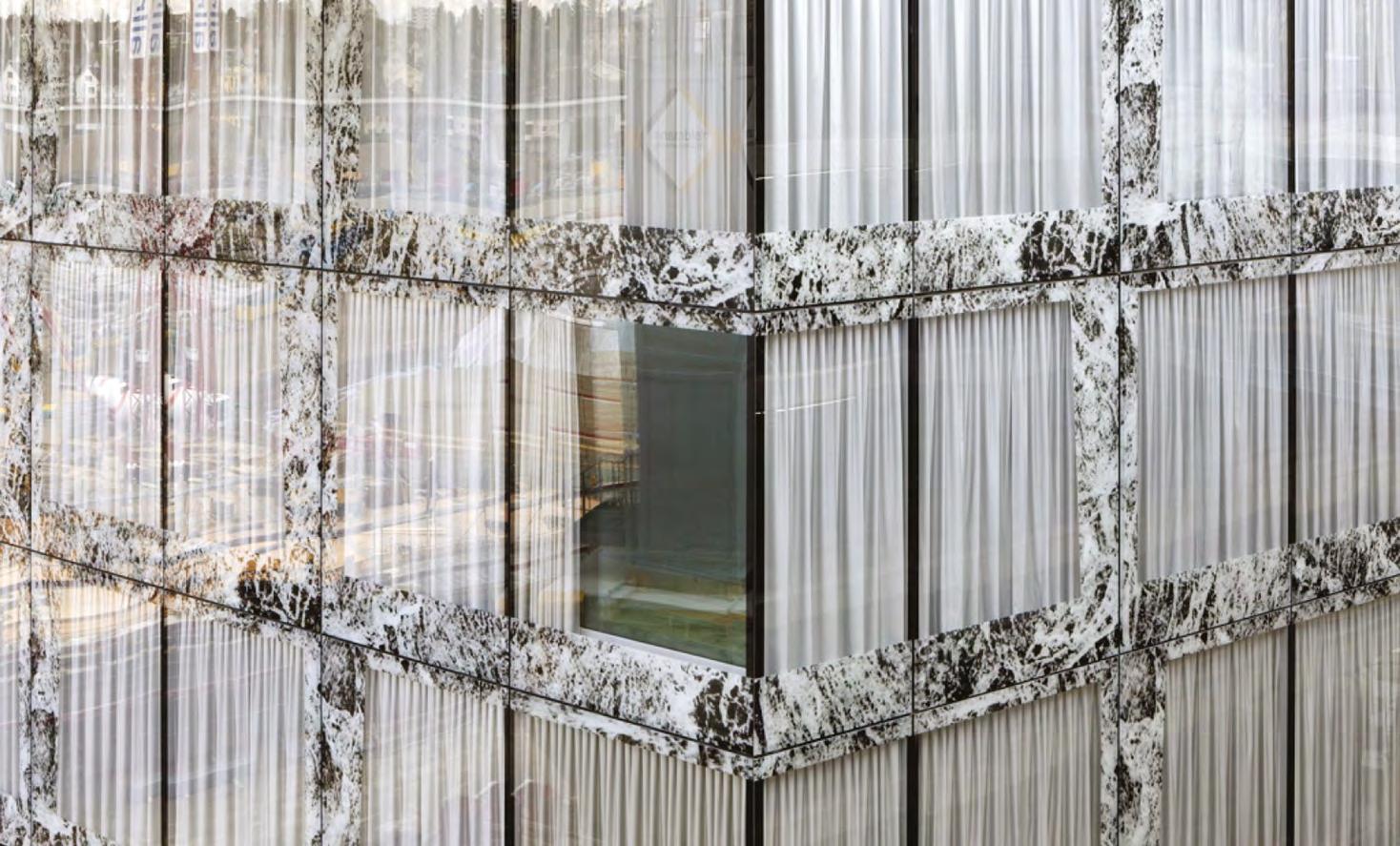
Fig. 02 Allianz Headquarters by WAA architect. Wiel Arets Architects
sheets of glass measuring 122x25 cm, the spread of large glass structures originated in the ‘80s from a new generation of architects (RFR, Perrault, Nouvel, Herzog and Meuron), who exploited the potential and the ability of tempered glass to maintain its integrity despite the holes located near the edges of the sheets, that allowed the suspension of the panes by bolts.
Nowadays, the maximum sizes in which laminated safety glass can be produced is amazing. The high demand for large sheets (with max dimensions 18.00 x 3.21 m) pushed to a renewal of the manufacturing process (i.e. the equipment for lamination, the furnaces for obtaining pre-stressed tempered glass) in order to make production more efficient and faster. Within a few years, this led from the glass skin of the Louvre in Lens, which Sanaa proportioned based on the largest available size, to the 10-m slabs used by Foster for the facade and roof of the Apple Store in New York City (Figure 03).
Dynamic products towards a User-Centered approach in glass façade design
For centuries, the main functionality of glass elements in façades has been to meet three principal requirements: to let in daylight, to grant a direct view of the immediate surroundings and, at the same time, to provide protection against wind and rain. The use of glass in architectural applications, especially in façades, has spread recently, in order to meet the current trends of lightness, robustness and energy efficiency.
Moreover, today the façade is one of the most complex parts of a building, which involves an integration among the load-bearing structure, building services, building physics and, not least, different architectural languages. Glass has a fundamental impact on the aesthetics of a building, as well as on the wellbeing of building occupants, mainly due to the transmission of light and the reduction of glare; glazed envelopes performance has a determinant influence on the space heating, cooling and lighting in buildings.
In this framework, the “future” design of transparent enclosures is closely related to a User-Centered approach in terms of user-specific functionalities and design features: a new understanding of adaptive facades is formulated, which is understood as adaptive to environmental conditions as well as to the user inside.
Novel products have been recently developed as kinetic elements of the building envelope, which can provide improved thermohygrometric and visual comfort inside buildings, depending on the intended use (residential, healthcare, school, office etc.). They are the outcomes of technological innovations in heat treatment processes, bending techniques, laminating materials and high strength connections (Wilson, 2010; Henriksen, 2013).
The most innovative technological products, now available on the market, are: LCD glass, heated glass, and electrochromic glass.
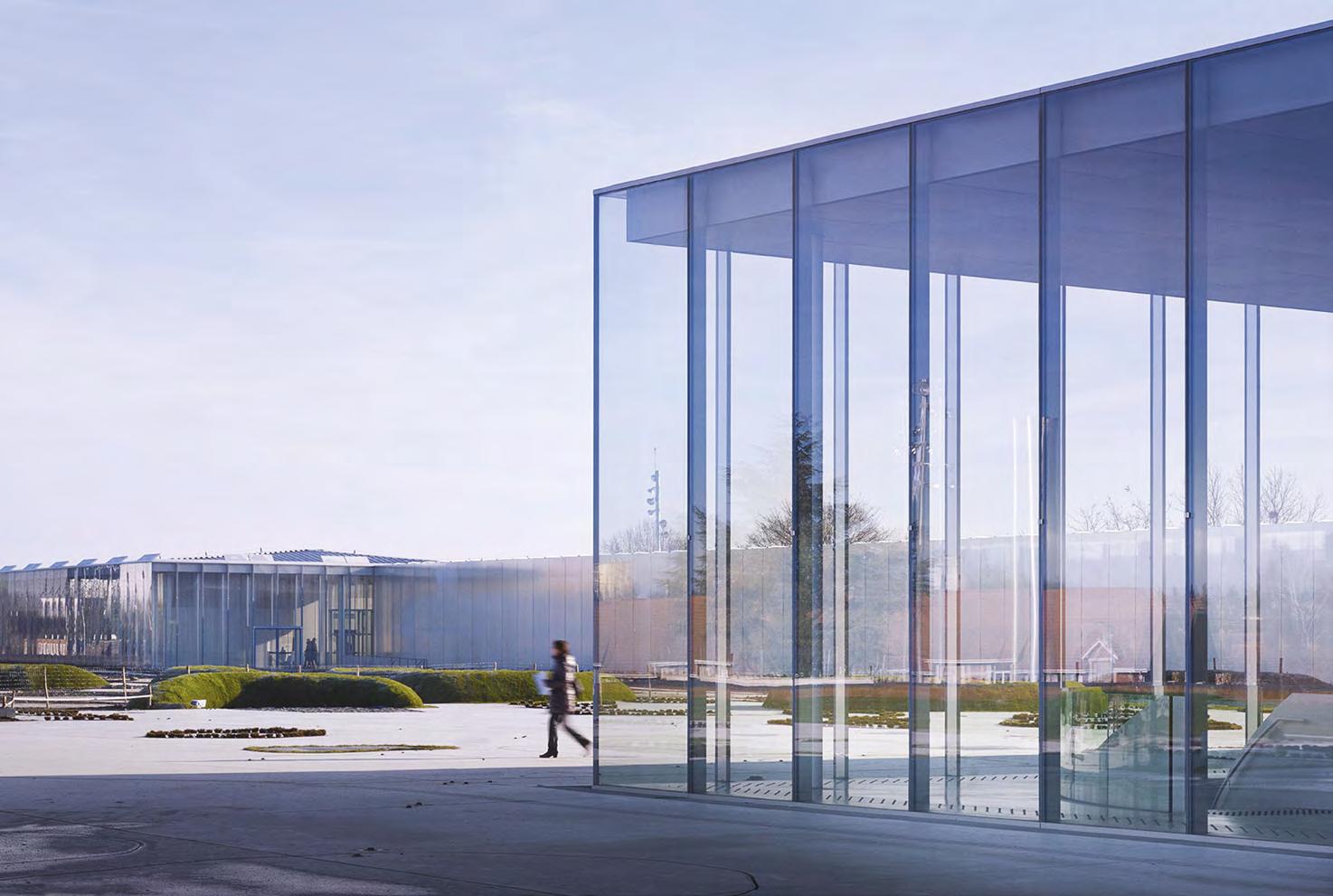
Fig. 03 Louvre-Lens by Sanaa. J. Lanoo
LCD panel is a laminated glass composed of two extra-clear glasses with an LCD liquid crystal film applied between two sheets of EVA or PVB. The active liquid crystal film is composed of two technical PET sheets coated with a transparent conducting deposit and assembled together with an extra-thin liquid crystal deposit. In the off position, the liquid crystals are not aligned: the glazing is therefore translucent. Its frosted appearance allows light to pass through without allowing vision. In the on position, the liquid crystals, stressed by the current, are aligned: the panel then instantly becomes transparent. This technology is suitable for use outdoors as well as indoors when increased levels of privacy are needed.
Heated glass uses an energy-efficient coating consisting of metal oxides, which acts as a protection from the cold, and improving thermal, visual and health-related comfort. Now, thanks to laser treatment of the conductive coating, the new generation of heated glass operates without the need for a transformer: single glass panels are directly connected to the power supply, like a standard electric radiator. The heated glass is available in double-glazed or triple-glazed IGUs and as laminated safety glass. It can be incorporated invisibly into window frames, glazing and greenhouses, either as a standard insulating window or as a heating system: it emits heat indoors or outdoors and can be used as a heating system (main or additional), preventing condensation and even being able to melt snow. The heat is radiated in a straight line, providing particularly comfortable heating that does not dry out the air inside rooms. In
fact, the cooling sensation of surfaces is reduced, thus optimizing the utilization of all living spaces.
Electrochromic (EC) glass panes can change light transmission properties in response to voltage and thus allow control over the amount of light and heat passing through. The electrochromic material changes its opacity, from a colored, translucent (usually blue) to a transparent state. The electrochromic glazing consists of a thin solid electrochromic film (electrolyte) which is sandwiched between two layers of glass. When an electric voltage is applied, an electrochemical reaction triggers the migration of ions from one electrode to the other one, causing a change in the color of the glass, from clear to dark. Darkening occurs from the edges, moving inward, and is a slow process, ranging from many seconds to several minutes depending on window size. Once the change has been affected, no electricity is needed for maintaining the particular shade which has been reached: the system stores a sort of inner “memory” because the electrolyte has a low electronic conductivity. To go back to the previous the conditions of transparency, the polarity must be reversed, allowing cations to leave the electrode and migrate to the counter electrode. Electrochromic devices can considerably decrease the light transmission and can allow control over the amount of light and heat passing through a glass façade, by modulating the potential difference (Figure 04).
Durability in electrochromic glazing is a current issue with having to cope with large number of switching cycle s to survive a reasonable life-time of 5-10 years: the warranty provided by the manufacturer is about 5 years. In addition, the incidence of labor for installation is 15-20% more than traditional glasses.
Architecture and building technology have been evolving fast in the last few decades and previous visions have now become a feasible reality. As a significant element of the overall building energy performance, there is an increasing use of multi-layered and multifunctional glazing systems than can actively adapt to occurring weather condition by changing their own properties (Henriksen, 2013).
The advantages of these applications are multiple and flexible in a huge variety of contexts: by using smart glasses, you can very easily and quickly change filter sight and light on demand, with the preservation of a high level of privacy. Although most business offices and rooms use switches or buttons to filter sight and light, a remote control and a mobile app can also be used to manage it. Adaptive glass can serve as a projection screen.
The possibility of varying thermal and light characteristics, such as solar factor, light transmission factor etc., can be the key to achieving considerable energy savings by reducing heat loss in winter and blocking UV rays in summer.
However, these elements must be dealt with in a balanced and conscious way from the earliest design stages. Buildings with huge glass façades can be energy-efficient, improving the performance of the envelope and the occupant comfort, but not all glass envelopes built in the last years perform well: in many cases HVAC systems have to compensate the overheating during the summer
and heat losses in winter time, therefore energy consumption badly exceeds the intended energy savings. Then, the same technological solutions cannot be taken uncritically as they need to adapt to different climates, orientations, building functions.
A virtuous example is the two-story atrium at Chabot College Student Service Center in Hayward, California, which has been glazed with EC glass: in this case, the use of EC glass has been integrated with a HVAC free, natural ventilation system, implementing a novel air-cooling strategy. The temperature of the atrium is controlled by radiant heating and cooling in the concrete slab, combined with roof and ceiling air scoops to enhance natural air flows. Implementation of EC glass gave sufficient range of solar control, so a fully glazed South and West facing atrium have been maintained (Paladino & Company, 2010).
Another critical issue at present is the high cost of these products and the difficulties associated with installation, which must be done by qualified personnel. In addition, these technologies operate only through the use of electricity and therefore result in increased electricity consumption.
In future years, however, it is assumed that these aspects can be managed in a more optimized manner, and production costs will be reduced due to technological progress. Indeed, the perspective is that, in case of dynamic glass intended for building envelopes, the actual quest is for variable transparency, durability, energy savings, ease of maintenance: these issues shall be taken into account as stringent design requirements, in order to enable the creation of energy-efficient and comfortable space in response both to the exterior environment and the needs of the building’s occupants.

Fig. 04 The performance of Electrochromic (EC) glass panes. Courtesy of SageGlass
Conclusions
The future of glass still has many possibilities for innovation, the industry has tried to improve the performance of this material from every point of view as an answer to a demand for “reliability” and “adaptability”.
The first led to the development of interesting design and product experiments, going as far as the recent invention of ultra-thin glasses with a thickness of up to 25 µm to be used in OLED applications (such as the one patented by Schott AG); of glasses integrated with nanotechnology, considered the technology of the twentyfirst Century, which in addition to adding additives to the composition of the glass to improve the strength characteristics, allow for the manipulation of its molecular structure to improve even the less positive properties of the material, up to become a building material, comparable in reliability to metals.
The second refers to materials capable of changing their conformation to external conditions and adapting to the specific needs of users. The latest innovations are the experimentation of ultra-strong honeycomb armored glass used in flooring (Solar Roadways) which, in addition to supporting up to 1,500 t of weight and providing information to users via luminous signs (road signs, dangerous conditions, etc.) they produce electricity (for one charge on a kilometer of road they supply energy to 1,000 homes); of self-cleaning glass capable of recovering daylight and then putting it back into service on request in the form of heat (Center for Materials Science & Engineering of MIT), or perhaps, in the future, of new products that will allow them to be waterproof but at the same time breathable.
References
Campioli, A. (1993). Il contesto del progetto. Il costruire contemporaneo tra sperimentalismo high-tech e diffusione delle tecnologie industriali. Milano: Franco Angeli. Dall’Olio, L. (1997). Arte e Architettura: nuove corrispondenze. Torino: Testo & Immagine. Galimberti, U. (1999). Psiche e Techne. L’uomo nell’era della tecnica. Milano: Mondolibri. Henriksen, T. (2013). The future of the glass industry. Glass Performance Days (GPD). Tampere: Proceedings of the 2013, pp. 2284-2288. Koster, H. (2004). Dynamic daylighting architecture: basics, systems, project. Basel, Boston, Berlin: Birkhauser. La Creta, R., Truppi, C. (1994). L’architetto tra tecnologia e progetto. Milano: Franco Angeli. Lévy, P. (1994). L’intelligence collective. Pour une anthropologie du cyberespace. Paris: La Découverte. Losasso, M. (1991). Architettura: tecnologia e complessità. Napoli: Clean. Maspoli, R., Saccomandi, M., Besser, Y. (2012). Vetri immagine&innovazione: il vetro come espressione creativa nella riqualificazione delle architetture post-industriali. Genova: De Ferrari. Nardi, G. (1979). Tecnologia dell’architettura e industrializzazione nell’edilizia. Milano: Franco Angeli. Paladino & Company (2010). Performance Assessment of Electrochromic coatings and control scenarios (online). In https:// www.sageglass.com/sites/default/files/whitepaper_final.pdf (last accessed August 2022). Sinopoli, N., Tatano, V. (2002). Sulle tracce dell’innovazione. Tra tecniche e architettura. Milano: Franco Angeli. Wilson, A. (2010). It’s time to rethink the all-glass building (online). In https://www.buildinggreen.com/blog/its-time-rethinkall-glass-building (last accessed August 2022).



